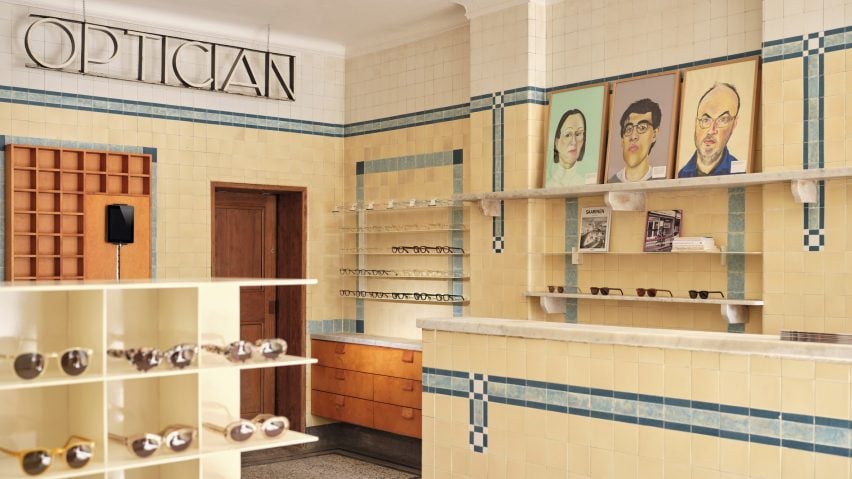Local studio EBBA Architects has designed a store for eyewear brand Cubitts that preserves and draws on the original 1930s interior of the traditional F Cooke restaurant on London's Broadway Market.
The restaurant, which sold cockney dishes such as jellied eel and pie and mash, had been located on the east London street since 1900 but was given a modernist update in the 1930s.
EBBA Architects turned the space into a 145-square-metre Cubitts store but kept almost all the original interiors of the Grade II-listed restaurant, which had been unoccupied since 2019.
F Cooke's marble tables were given new legs made from stained birch plywood and now hold eyewear display cases in a sunny hue that matches the original wall tiles.
"The tables are original but we designed the legs to kind of make it feel like a new feature," EBBA Architects founder Benni Allan told Dezeen.
"The table has just been scrubbed up," he said. "Imagine how many nice pies have been eaten on that table."
"I think what's nice is that everything below [the tables] has had this quite warm treatment to bring in a nice texture and tone, and then everything above is much lighter."
The studio also kept the original stained-glass windows and the counter that used to serve food, turning it into a point of sale, while a repair station for glasses fills the window facing the street.
Pale yellow tiles bordered by bands of contrasting blue and turquoise tiles decorate the walls. These are the original interior from 1930 and were cleaned using "loads of elbow grease", Allan said.
In the main showroom of the two-storey store, the studio also kept the restaurant's mirrors, only removing one to create a display case and sales point.
"All the additions are kind of appendages or accoutrements on the base of the original structure," Cubitts founder Tom Broughton told Dezeen.
Downstairs, EBBA Architects made more interventions, as the space was dark and hadn't been furnished to the same level as the main upstairs space.
"It was really quite dark and dingy down there, so the colours from upstairs informed this really bright orange in the staircase," Allan said.
The studio used stained plywood to create a sliding wood screen with a square pattern based on the tiles in the main store, as well as creating a bright-coloured staff room with a "secret door".
It also added tiled floors with a decorative pattern in a colour palette that references that of the restaurant.
"There's that really beautiful intricate detailing upstairs, so we wanted to sort of mirror that down here with these different patterns in the floor," Allan said.
Downstairs also holds the eyewear testing centre, which is located underneath the street above.
Broughton and Allan tried to keep as many of the original details from the restaurant as possible. The tank where the live eels were once kept before being boiled is left standing in an outdoor space downstairs and the restaurant's sign remains above the front door.
One of the benches, on which people used to sit and eat, has been placed outside the store. And the Cooke family behind the restaurant chain – which still has two outposts – has lent Cubitts some of its original pie tins alongside the bowls used to serve jellied eels and a picture of founder Bob Cooke.
The Cubitts Broadway Market store is located in an area that has become increasingly gentrified over the past decade, with many local shops being taken over by chains.
Though some people have been nostalgic about the time when the store was a pie-and-mash shop, Allan and Broughton said there have also been positive reactions to the refurbishment
"People have actually been really chuffed that it stayed the same," Allan said.
"Someone could come in here in a decade or two and actually put it back into a pie and mash shop. Even though [the changes] feel purposeful, it's quite a light touch. If anything, we've kind of given it a new lease of life, because it was actually pretty grimy."
This is also the general tactic for Cubitts, Broughton said. When looking for new stores, the brand focuses on finding spaces that have existing interiors, with other outposts set in a 19th-century townhouse in Belgravia and a Victorian arcade in Leeds.
"Ideally, [the store] already has this existing structure and framework that you can clean up and add a bit of product and a few fittings to," he said.
"And that's the really nice thing, right? If you can take something that's already beautiful, give it a new lease of life and make it relevant to someone today, that's really cool."

